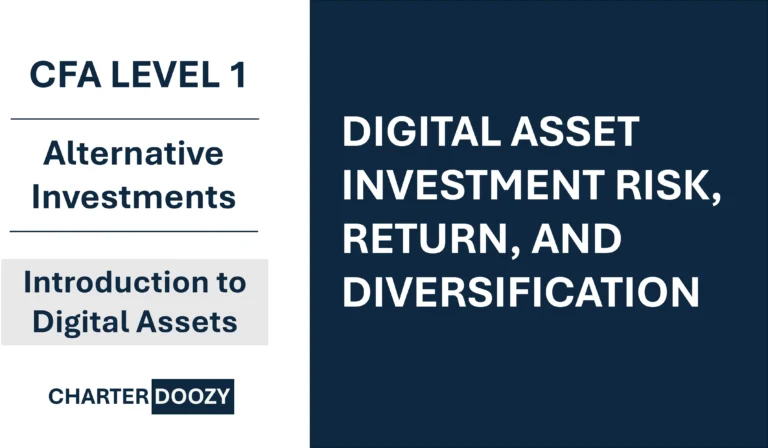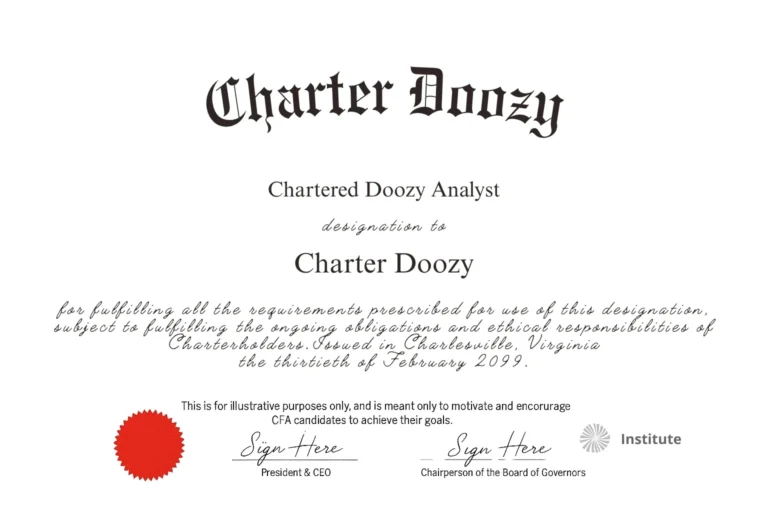Transcription
[00:00:00] Slide 2 – Big Picture Overview
Great. And how’s it everyone? Welcome back. This is our final video for the Level one Digital Assets section. We’ve touched on some of these things at a very high level, specifically risk return diversification. We have touched on these, but in this video we’re gonna delve a little bit deeper into each of them.
So big picture before we jump in. This section is all about analyzing risk, return, and diversification potential of digital assets. Why does it matter? Well, because even though crypto has exciting upside potential, which obviously where all the focus is and all the media, et cetera, it does come with wild price swings and unique risks.
So in this video, we’re gonna explore how digital assets behave differently from traditional assets with traditional investments. What their return profile looks like and whether they actually help diversify your portfolio or do they just add a bunch of noise. So this is the kind of insight you’re gonna need as a professional as a CFA candidate, when evaluating new asset classes, and doing it in a way that’s disciplined.
I think you’re gonna enjoy this. Let’s jump straight in.
[00:01:16] Slide 3 – Risk Characteristics of Digital Assets
Alright. We begin by looking at the risk characteristics of digital assets. Why start with the risk? Because there’s just so many different types of risks that exist in this world of digital assets, especially given its early nature. A lot of it’s not yet developed, and so that obviously introduces. Risks and vulnerabilities, which we’re gonna discuss
Now,
Digital assets obviously show extreme volatility and we’re aware of that. I’m sharing this picture here, this chart of just a couple months back of, the Bitcoin to US dollar price. And you can see is extreme volatility far beyond what you would see in the equity markets or the commodities markets.
But you’re not just exposed, to market risk or these, market cycles. You’re dealing with a bunch of extra risks, which don’t necessarily exist in the traditional asset space. So number one is regulatory risk. So laws can and do change quickly and vary across regions. Secondly, technology risks, bugs in code or upgrades can introduce the vulnerabilities.
And we’ve seen, we’ve seen exchanges, crypto exchanges go down. We’ve seen hacks using vulnerabilities. We’ve seen coins go down. And so these things, these risks from technology point of view are very real. There’s custody risk, so if you lose your private key as an example, the asset disappears. It’s gone.
There’s no way to get it back if that key is, is vanished. And lastly, market manipulation. So whales, pump and dump schemes, these are not just hypothetical. They’ve happened. They will continue to happen and they are a part of an early developing market for better or for worse. And so these are the risks.
These need to be thought about. Mitigations need to be put in place, especially if you’re doing this on behalf of other people. Private wealth, portfolio management, institutional or individual, this is what being a professional asset manager is all about. It’s really breaking it up, going through it, risk by risk and making sure that you understand the risks and that you’re prepared to take those risks.
And if not, are there mitigations you can put in place to then allow exposure into these new and potentially highly lucrative markets.
[00:03:47] Slide 4 – Return Characteristics
Oh yeah, baby. Now it’s time to talk. Return characteristics of digital assets. And of course, that’s what we all love to talk about. So let’s get into it. Bitcoin and Ethereum, obviously, if you’ve been following this space for a while, have delivered eye popping returns historically, especially for those who got in early.
And of course, that’s the caveat we all want to forget, but obviously those returns are not normal. And when I say not normal, I mean it in two senses. Firstly, in the normal English sense, it’s not normal. Those returns are they bubble like in nature, unlikely to repeat themselves. If you got on the wave, that’s great.
If not, I’m not gonna say don’t join, but it’s unlikely you’re gonna see tens and hundreds and thousands of percent returns, in the future.
They’re also not normal returns if you analyze them on a statistical basis. So the returns of digital assets tend to have high skewness and fat tails, what we call fat tails or kurtosis if you haven’t yet gotten into the quant sections.
Um, and that means there are frequent and sharp drawdowns. In other words, you might be up, let’s say 300% in one year, but then down 60% the next. And so price movements are driven much more by narrative and hype than by the fundamentals. And like we said in one of the previous videos, these digital assets tend not to have cashflow streams.
So if you think about Bitcoin, it doesn’t produce a regular cashflow stream like a dividend or a coupon, uh, where more traditional assets would do that. And so what it’s left with is that it’s quite hard to value the true value of these underlying assets. And it’s left much more to sentiment and speculation.
And so also to talk about is that price discovery tends to be fragmented again, there’s no single market that sets the correct price, and because they’re different exchanges and buying and selling are happening in different pockets, there tends to be, differences in terms of value. And again, that just creates additional volatility in these returns.
[00:05:59] Slide 5 – Diversification Potential
Okay. Something we have talked about in a previous video, diversification potential of digital assets. So the question is, does crypto diversify a portfolio? And the answer is a resounding, it depends. I’m sure that’s the answer you wanted to hear. So it really, that’s the truth. It does depend. Sometimes yes, sometimes no.
So initially. When crypto was first introduced, it showed actually quite low correlation with traditional asset classes, making it quite a great diversifier. But what we then saw was during market stresses, those correlations tended to rise, which meant that all of a sudden these crypto assets were moving up and down a lot closer in sync with traditional assets. And so what this basically showed is a traditional or a classic risk-on risk-off dynamic. And what I mean by that is that when fear hits the market, everything sells off together. So, investors, when they pull out of risky assets, they pull out of their stocks, they pull out of their crypto positions, and they move into, let’s say gold and cash.
And so what you then see is that. Even though the fundamentals driving, let’s say a digital asset or may be very different to a traditional asset, the investor sentiment is actually causing these things to correlate in a much bigger way than we maybe would’ve thought. But still a small allocation if done wisely, actually can improve improver portfolios sharp ratio.
So that means it is introducing an element of diversification into a portfolio and then obviously the benefits of that. But the caveat is that you do have to monitor those correlations in real time.
[00:07:49] Slide 6 – Investment Features Summary
Okay. Those of you who have worked with me in the past will know that I’m a strong proponent of active studying. So what that means is instead of just sitting here and listening to me lecture, obviously there’s some benefit to that, I hope. But active studying means that you need to now take. Over and start working through this material yourself to really build that independence and that understanding at a deeper level.
And so what I’ve included here is a table for you to look through. It’s also available for download on the chart to dozi website. And, uh, in it I basically have mapped out the key features or characteristics of digital assets versus more traditional assets, equities, bonds, real estate, and commodities.
And it’s worthwhile going through it sell by sell. I’m not gonna do it in this video and working through to really understand how these different asset losses, differ one from the other and the unique space which digital assets have carved out, and continuing to carve out, in the investment environment. So I’m not going to spend a lot of time now.
Press pause, go download the, the PDF or the, the image of this and work through it. This is really where, if you can understand this, I think it’s a great summary of a lot of the material covered in this chapter around digital assets. And I think it will set a good foundation for you both in terms of future exams, this exam, and your career as a portfolio manager.
[00:09:25] Slide 7 – Key Takeaways
Okay, let’s start wrapping this up and let’s take us home. A few key takeaways from what we’ve learned, digital assets come with distinct risk factors that require fresh thinking because they’re not the typical risks that you may see in traditional asset classes. Returns obviously can be spectacular, but also unstable and actually quite hard to model.
Diversification benefits are there, but not guaranteed. They’re conditional on market regimes. And portfolio inclusion requires both a quantitative analysis and just good judgment. So the bottom line, treat crypto like any other asset objectively and analytically.
[00:10:08] Slide 8 – Practice Question 1
Okay. A couple of practice questions just to test your understanding. As usual, feel free to hit the pause button if you require more time, but I’m gonna zoom through it you. So let’s start with question one. Which of the following is most likely a unique risk associated with digital assets?
[00:10:27] Slide 9 – Answer 1
The correct answer is, B, digital assets can fail due to code vulnerabilities or protocol errors and things like that.
Something. You don’t typically worry about with equities or bonds.
[00:10:40] Slide 10 – Question 2
Next one, digital assets are least likely to show which of the following characteristics?
[00:10:48] Slide 11 – Answer 2
Answer B. Volatility is a defining feature of most crypto assets.
[00:10:55] Slide 12 – Question 3
Question three. Which statement best describes the correlation of digital assets with traditional asset classes?
[00:11:05] Slide 13 – Answer 3
The answer here is C. Crypto assets can diversify portfolios during comm periods, but correlation often spikes during crises.
[00:11:18] Slide 14 – Question 4
Let’s see if you remember the portfolio angle. Adding a small allocation of digital assets to a traditional portfolio is most likely to?
[00:11:31] Slide 15 – Answer 4
Answer there is C. Even though volatile, a small crypto allocation may increase portfolio efficiency, if managed with discipline.
[00:11:42] Slide 16 – Final Conclusion
All right. Let’s recap what you now know.
Digital asset risks -volatility, technical bugs, shifting regulations.
Return behaviors are not normal. High risk, high reward sort of profiles.
Diversification possible, but often conditional.
And portfolio application requires both data and a heck of a load of judgment.
Okay, we will leave it there. That’s the end of digital assets for the CFA level one exam. As usual, there’s a lot more that we could talk about, but if you have specific questions or comments or jokes, feel free to reach out. You can email me. You can, hit up on Charter Doozy website or on social media.
Get in touch and let’s start a conversation.

Crypto Returns Look Sexy—Until You Zoom Out
Why Digital Assets Can Explode Your Portfolio… or Your Nerves
There’s nothing like a good chart to tempt you.
Double-digit daily gains. A coin that 10x’d overnight. Green candles that stretch up and to the right.
Crypto returns can feel like rocket fuel. But before you strap in, pause and zoom out.
Because digital assets aren’t just a new investment class. They are a different species of risk, return, and diversification. And if you’re not careful, they’ll mess with your instincts, your models, and your client’s blood pressure.
This article is for CFA candidates and professionals who want to understand how crypto behaves inside a portfolio. Not just the hype stories. But the statistical, structural, and psychological truths of digital asset investing.
Let’s dissect the three key dimensions: risk, return, and diversification.
1. Volatility Isn’t a Bug. It’s the Feature.
Bitcoin’s annualized volatility routinely hits 60% to 80%. Ethereum can be even wilder. For context, equities hover around 15%, and bonds often sit in the single digits.
In plain terms:
A stock might fluctuate 1% in a day.
A crypto asset might swing 10% before lunch.
This isn’t a temporary phase. It’s intrinsic to early-stage, speculative, thinly traded, and sentiment-driven markets.
As an investor:
You must size positions strategically.
You must expect drawdowns of 50% or more.
You must model tail risk scenarios that would be absurd in traditional assets.
Volatility isn’t bad. But it’s not optional. It’s the price of admission.
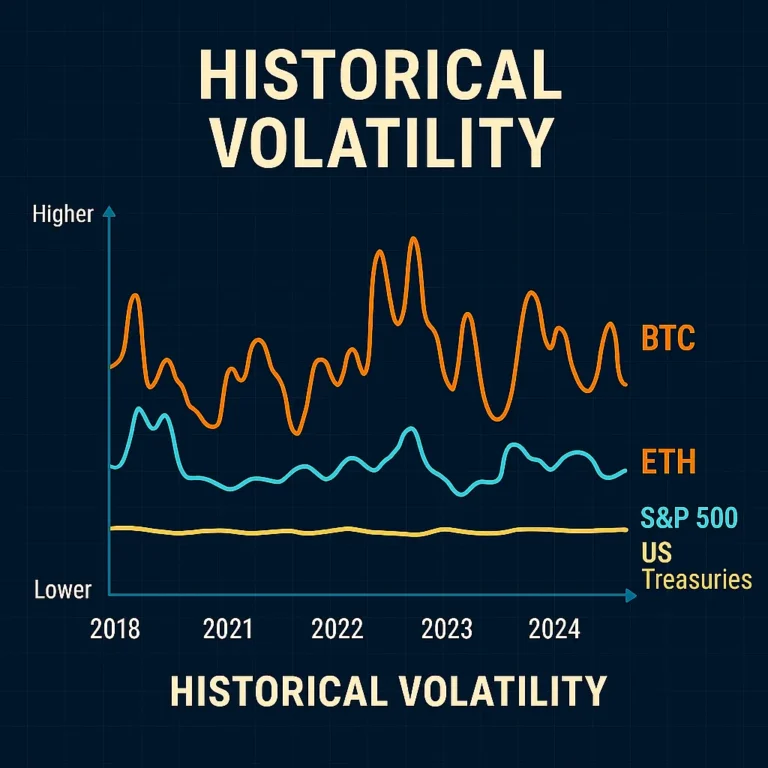
2. Return Profiles Are Non-Normal—And That’s the Point
Crypto returns don’t follow tidy bell curves. They are leptokurtic (fat tails) and skewed (up and to the right… until they’re not).
This creates:
Massive upside asymmetry (e.g., Bitcoin’s 1000x run from 2010 to 2020)
Long periods of stagnation or collapse (e.g., 85% drawdowns)
From a CFA perspective:
Standard deviation alone is insufficient
Use metrics like Sortino Ratio (downside deviation)
Consider skewness and kurtosis explicitly
Clients and portfolio managers will feel these return behaviors in their guts. Your job is to translate stats into expectations.
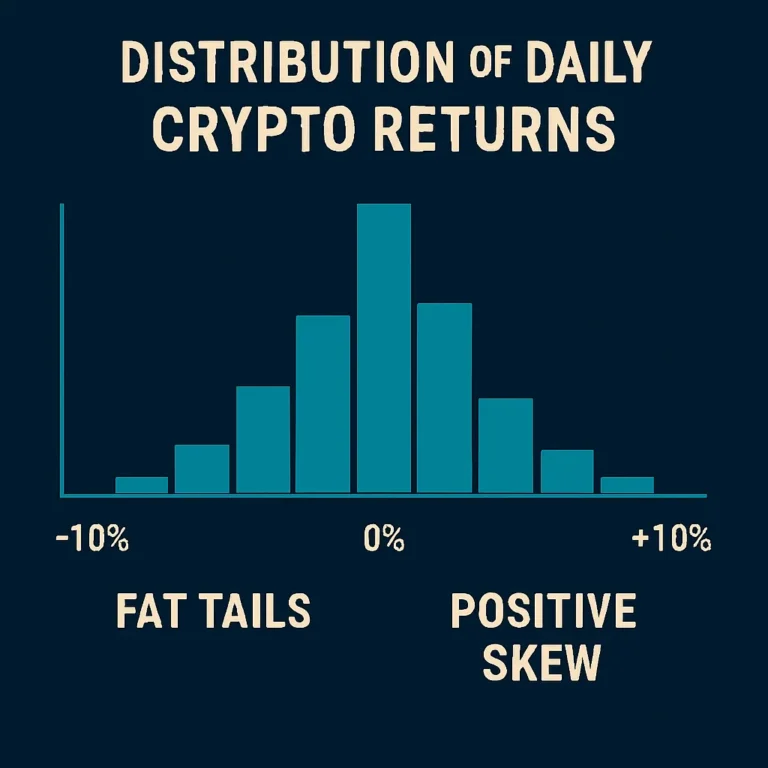
3. Diversification Is Real—But Not Constant
Crypto’s biggest allure to professionals? It offers uncorrelated or low-correlated returns.
Here’s the truth:
Crypto shows low correlation with equities, bonds, and commodities in calm markets.
But in stress events, correlations spike. Everything sells off. Liquidity vanishes.
In practice:
Crypto offers some diversification, but it’s regime-dependent.
You must monitor rolling correlations, not just point-in-time metrics.
It diversifies long-term returns, not necessarily short-term stress.
A correlation heatmap will often mislead. Zoom into time slices.
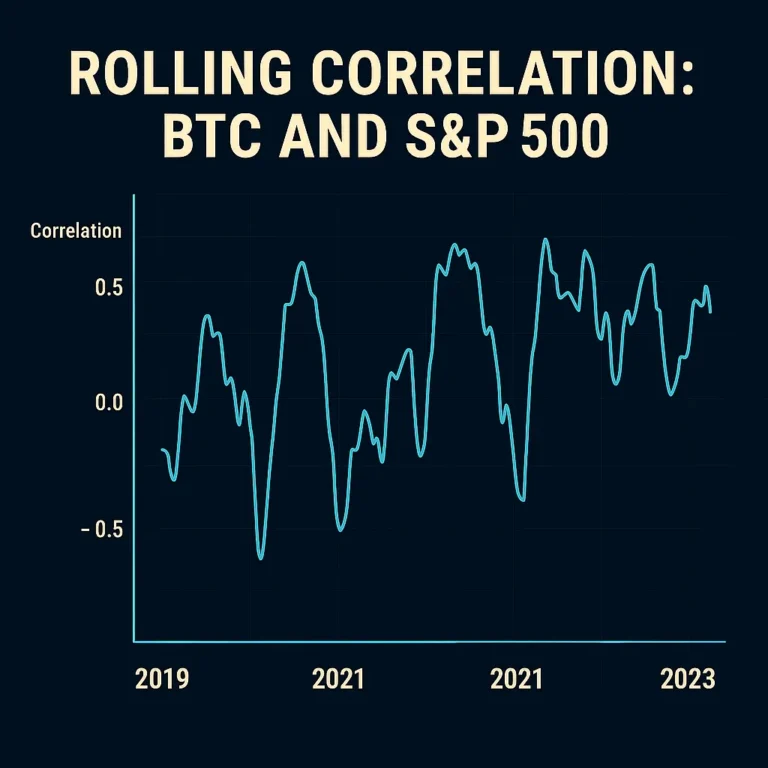
4. New Risks Require New Mental Models
Crypto brings with it a suite of digital-native risks that don’t exist in traditional finance.
Traditional Risks vs. Digital-Specific Risks
| Traditional Risk | Digital-Specific Risk |
|---|---|
| Market risk | Smart contract risk |
| Credit risk | Protocol governance risk |
| Liquidity risk | Token illiquidity (DEX failure) |
| Operational risk | Wallet mismanagement |
| Regulatory risk | Unclear or retroactive regulation |
You can’t use the same frameworks and expect the same results.
Questions to recalibrate:
Is your counterparty an exchange or a smart contract?
Is your custody model centralized or self-custodial?
What happens if the token you hold is reclassified as a security?
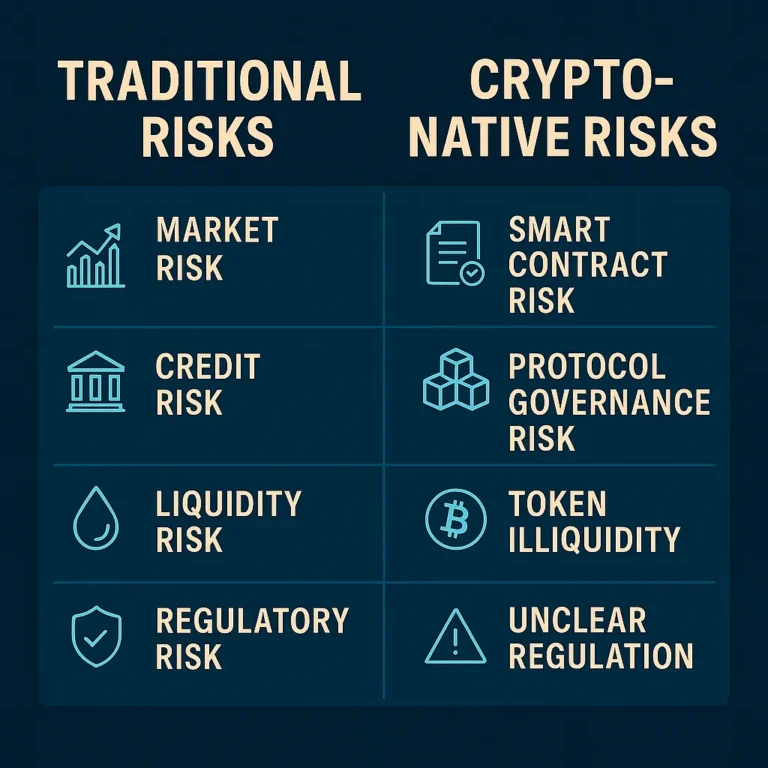
5. The Liquidity Mirage
Bitcoin and Ethereum have deep markets. But go down the coin cap list, and liquidity evaporates fast.
You might see:
24/7 trading… but thin order books
Huge bid/ask spreads
Price manipulation by whales
The liquidity spectrum:
BTC/ETH ➔ Stablecoins ➔ Altcoins ➔ NFTs/Memecoins
This impacts:
Execution cost
Slippage
Portfolio rebalancing
Crisis exits
Liquidity isn’t just about daily volume. It’s about depth, resilience, and access under stress.
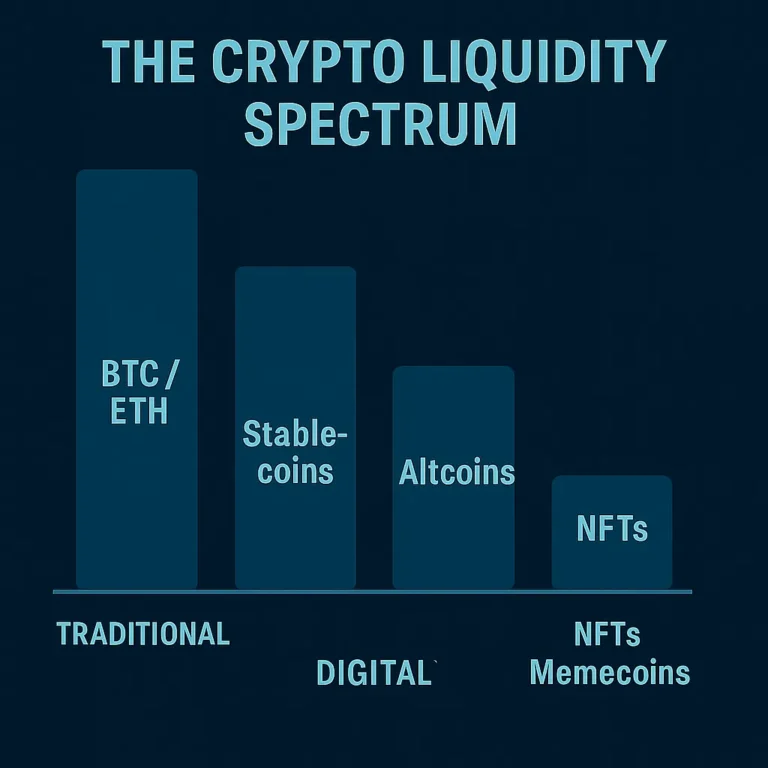
6. Behavioral Risks Multiply
The human brain is already bad at:
Handling drawdowns
Sticking to a strategy
Resisting FOMO
Now layer on:
24/7 markets
Meme coin hype
Constant price alerts
Twitter-fueled panic
Crypto magnifies behavioral risk. The volatility isn’t just in price. It’s in your own judgment.
CFA candidates need to model not just financial outcomes, but psychological bandwidth.
Sometimes the best allocation is not what the model says, but what the investor can hold without panic selling.
7. Realistic Portfolio Construction
Typical allocation ranges:
Conservative: 0% to 1%
Moderate risk: 1% to 3%
Aggressive/Opportunistic: 5% to 10%
Key principles:
Treat crypto as a high-volatility satellite asset
Use it to boost expected return, not lower volatility
Stress-test your model with 100% drawdown scenarios
Crypto should never be your whole portfolio. But ignoring it entirely may undercut long-term opportunity.
8. CFA-Level Metrics to Master
You don’t need to become a blockchain developer. But you do need to own these concepts:
Volatility clustering: crypto moves in violent bursts
Regime change modeling: correlations are time-varying
Fat tails: expect extreme outcomes more often than models predict
Asymmetric return profiles: small investments can drive large upside (or losses)
And most importantly:
Risk-adjusted returns are not just Sharpe ratios.
Crypto often fails Sharpe, but succeeds on convexity and optionality.
Think like an options trader. Not a bond manager.
Final Thoughts: Respect the Chaos, Harness the Edge
Crypto is young, wild, and unstable. But that doesn’t mean it’s useless.
It just means it requires a different toolkit.
Be humble about volatility
Be skeptical of backtests
Be clear on custody and classification
Be brutally honest about investor behavior
Digital assets are not for everyone. But for those who understand their mechanics and psychology, they offer something rare:
Non-linear upside
Structural diversification
A hedge against fiat and orthodoxy
That’s not hype. That’s math. And human nature.
So next time you see a green candle shooting up…
Don’t just cheer.
Zoom out.
And ask:
What’s the risk behind the return?
Because sexy returns aren’t free.
They’re just fast.
